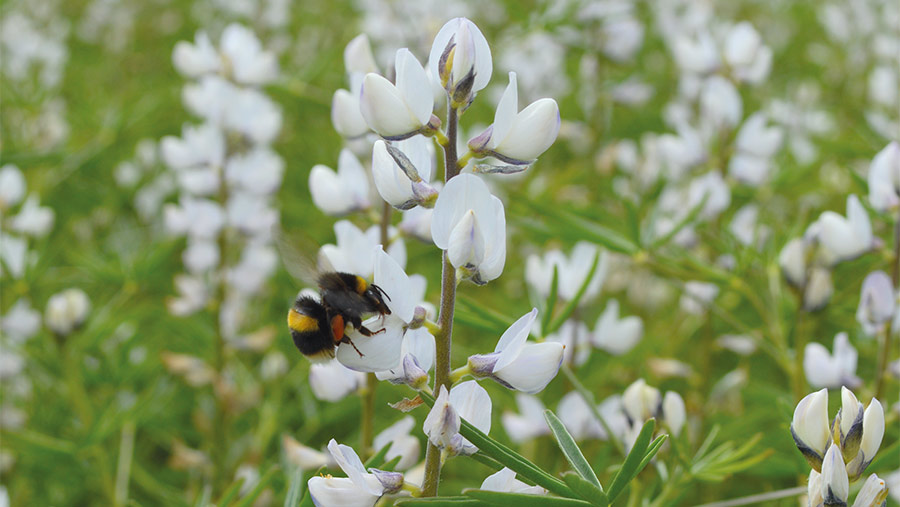Why lupins could finally make the breakthrough as a break crop

Lupins are finding a home on one Kent family-run farm as a useful spring-sown break crop, with a guaranteed price and a ready market for the protein-rich grain.
The leguminous crop has been about to make a breakthrough in the UK for decades, but now, better varieties and a search for more home-grown protein may help to support its popularity.
Earlier to harvest than soya beans and better to establish in dry springs than peas and beans, the crop – which is grown widely in the arid areas of Australia – is beginning to interest a big pig and poultry feed compounder.
Edward Batchelor and his sons, Steven and Ryan, were keen to find a different crop to grow this spring, because after a very wet autumn, many growers piled into spring barley while spring wheat seed soon sold out.
“Lupins look a promising crop in the rotation to spread the risk and workload with a guaranteed price and a ready home for them,” says Steven.
See also: How grower targets fish food market and blackgrass with bean crop
Buy-back contracts
The ready home comes via agronomy and distribution group Frontier, which offered buy-back contracts for 100ha of the crop last year, and expanding that to 300ha this year on farms from Kent up to Norfolk and across to Somerset.
Farm facts

Edward, Steven and Ryan Batchelor
- J Batchelor & Partners, Ford Manor Farm, Canterbury
- 600ha of mainly arable land (including Wingham Well Farm)
- Growing winter wheat, spring barley, peas, spring and winter beans, and spring and winter oilseed rape
Robert Nightingale, the group’s break crop specialist, says lupins give protein contents of 32-36%, above beans at 26-28% but below soya beans at 42-44%, making them a viable protein crop for the UK.
“We think lupins may have the edge over soya as they are earlier to harvest, in mid to late September,” he says.
Britain imports the equivalent of more than 3m tonnes of soya each year – 1m tonnes of beans and 2m tonnes of meal – largely from the US and Brazil – and mainly for animal feed, and all largely genetically modified (GM).
In a drive towards more sustainable farming practices, there has been a search for more UK-grown protein crops, with a small area of soya beans being grown, and an increased interest in peas, beans and now lupins.
Lupin option
So the agronomy group is offering buy-back contracts at £275/t for a lupin crop looking to yield 2-3t/ha – with an aim of 3t/ha – and variable costs expected to be lower than spring beans at about £250-£300/ha.
This could give gross margins of more than £500/ha, which could look attractive for a low-input crop, with sowing and harvesting not clashing with cereals and other break crops on the farm.
The crop was an attractive option on the Batchelors’ farm after they only managed to drill 30% of their planned autumn cereal crops in a very wet final quarter to 2019.
So where they were unable to drill winter wheat on their Wingham Well Farm, nearly six miles east of Canterbury, following oilseed rape, there was room for 35ha of sweet blue lupins among other break crops of beans, peas and oilseed rape.
“We were looking for something different to try, and to give us a good entry for winter wheat,” says Edward.
Crop attractions
The attractions of the crop for the farm were the guaranteed price, better establishment in a dry spring when peas and beans can struggle, and also spreading the farm’s cropping and the risk.
A block of medium loam land initially destined for winter wheat was minimum tilled in the spring, and then drilled on 8 April with lupins at 100 seeds/sq m, costing about £150-£160/ha.
Nick Peters, agronomist with Frontier, says lupins can be drilled after beans and peas have been sown, preferably into a warm and moist seed-bed, giving growers more time to control any extra flushes of blackgrass.
The seed used was of the Polish blue variety Rumba, inoculated – similar to soya – to activate the plant’s root nodules to fix nitrogen.
Although lupins are a legume, it is being advised to add 25kg/ha of nitrogen fertiliser in the seed-bed to get the crop growing. While phosphate and potash should be applied at up to 50kg/ha of each depending on soil indices.
Limited chemistry
Pre-emergence herbicide chemistry is very limited, so pendimethalin (Stomp) and clomazone (Gamit) were used for weed control before crop emergence.
Foliar phosphite to help the crop scavenge for nutrients is applied along with manganese, while a pyrethroid spray may be needed in late April against bean seed fly. No fungicides are planned.
Harvest is likely to come after peas and beans, and the lupin crop will be treated with glyphosate – as diquat is no longer available – and cut in late September.
“Last year, lupin yields were 2-3t/ha, and for this crop, we would like to see 3t/ha,” says Mr Peters.
He points out that lupins need to be yielding 2.5t/ha to be viable, and at this level they are probably giving the same gross margin as a 4t/ha crop of spring beans.
The lupin plant has a big tap root so will hopefully improve the soil structure and give a good entry for wheat, which along with other plus points, such as the guaranteed price and spreading the farm’s workload and risk, may make the crop an interesting option for the future.
“The lupins are looking promising at the moment, and if they yield well, we could be looking for another 35ha next year,” says Steven.
Growing lupins
Blue lupins are narrow leaved and slightly earlier to mature. They have slightly lower proteins at 32% compared with white lupins at 36%.
The blue lupins do not thrive on soils above a pH of 7.5, so should not be grown on alkaline soils, such as chalks. White lupins are more tolerant of higher pHs.
Frontier advises that lupins can be grown south-east of a line between the mouth of the River Severn and The Wash.
Lupin uses
Pig and poultry feed compounder ABN is looking for alternative sustainable protein sources, especially those that can be grown in the UK.
Initial trials using lupin protein in pig and poultry rations are looking “very positive”, and the group will have 600t-plus to use after this harvest.
ABN is owned by Associated British Foods, which also owns 50% of Frontier, with US grain giant Cargill owning the other 50%.
The Frontier buy-back contract at £275/t is about a £40/t discount to soya beans.
The group also has contracts for beans at a premium over feed wheat futures for use in areas such as salmon fish food, as well as for human consumption.

